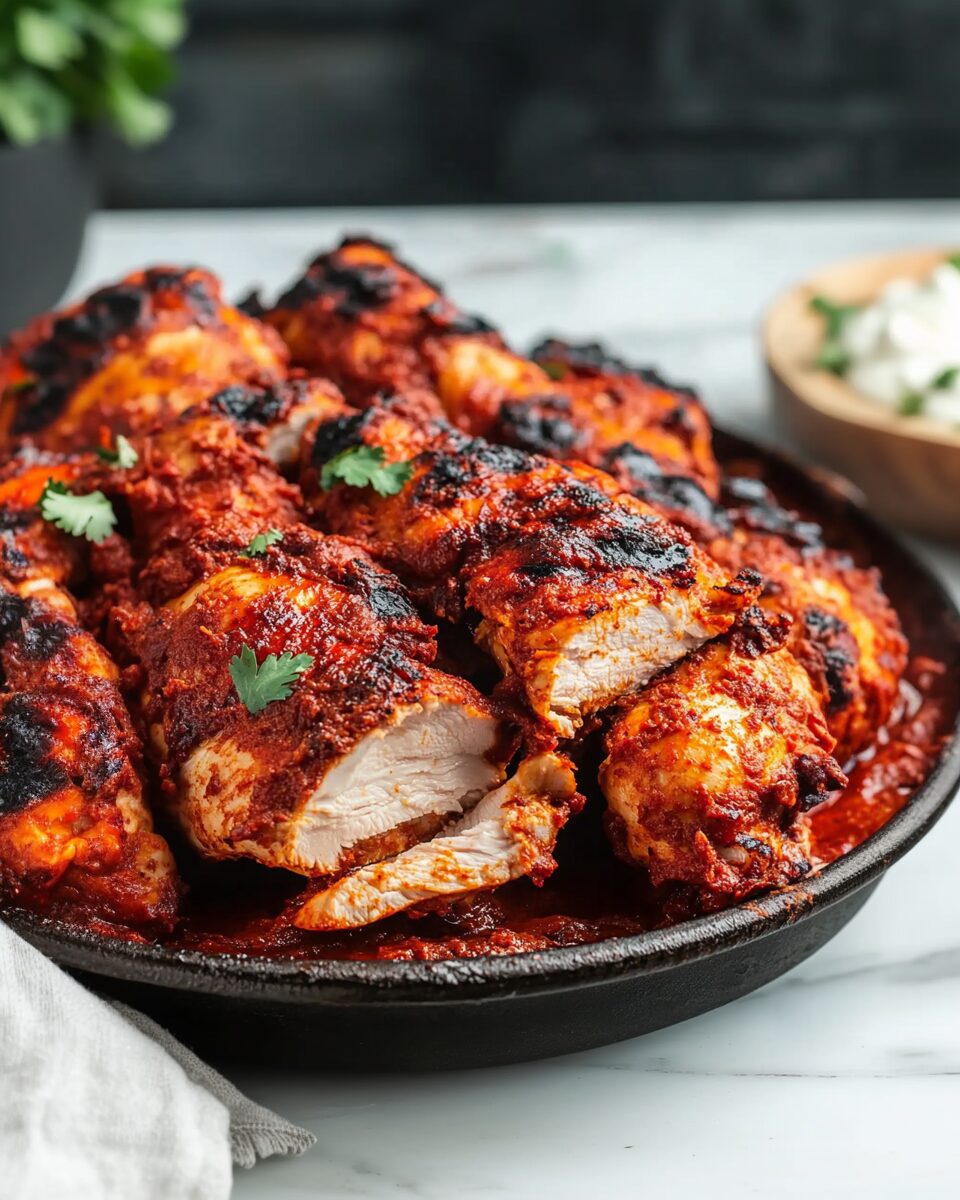Tandoori Chicken is a classic Indian dish renowned for its vibrant color and smoky flavor. Traditionally cooked in a tandoor—a cylindrical clay oven—this recipe adapts the method for home kitchens, allowing you to achieve the same rich taste using a conventional oven. The chicken is marinated in a spiced yogurt mixture, resulting in tender, flavorful meat with a tantalizing aroma.
Full Recipe:
Ingredients
- 1.5 kg (3.3 lbs) chicken pieces (drumsticks and thighs preferred)
- 1 ½ cups plain full-fat yogurt
- 2 tablespoons vegetable oil
- 1 ½ tablespoons lemon juice
- 2 teaspoons grated fresh ginger
- 5 garlic cloves, minced
- 3 teaspoons garam masala
- 1 ½ tablespoons paprika (for color)
- 1 teaspoon turmeric powder
- 2 teaspoons ground cumin
- 2 ½ teaspoons ground coriander
- ½ teaspoon cayenne pepper (adjust to taste)
- 1 teaspoon salt
- Fresh cilantro leaves, for garnish
- Lemon wedges, for serving
Directions
-
Prepare the Marinade: In a large mixing bowl, combine the yogurt, oil, lemon juice, grated ginger, minced garlic, garam masala, paprika, turmeric, cumin, coriander, cayenne pepper, and salt. Stir until all ingredients are well blended.
-
Marinate the Chicken: Make two to three deep slashes in each piece of chicken to allow the marinade to penetrate. Add the chicken pieces to the bowl, ensuring each piece is thoroughly coated. Cover and refrigerate for at least 12 hours, preferably up to 24 hours.
-
Prepare for Baking: Preheat your oven to 200°C (400°F). Line a baking tray with aluminum foil and place a wire rack over it. Lightly grease the rack.
-
Bake the Chicken: Arrange the chicken on the rack and bake for 30 minutes. Turn the pieces and bake for another 10-15 minutes, or until cooked through and slightly charred. Internal temp should reach 75°C (165°F).
-
Serve: Rest the chicken for a few minutes. Garnish with cilantro and serve with lemon wedges. Pairs well with rice, naan, or salad.
Nutritional Facts (Per serving, approx. 6 servings)
- Calories: 320 kcal
- Protein: 40g
- Total Fat: 15g
- Saturated Fat: 4g
- Cholesterol: 120mg
- Carbohydrates: 5g
- Dietary Fiber: 1g
- Sugars: 3g
- Sodium: 600mg
- Potassium: 500mg
Historical Origins
The genesis of Tandoori Chicken is deeply rooted in the ancient culinary traditions of the Indian subcontinent. Archaeological findings suggest that as early as 3000 BCE, the Harappan civilization utilized clay ovens resembling modern tandoors to prepare roasted meats, indicating a prehistoric appreciation for this cooking technique.
The contemporary incarnation of Tandoori Chicken, however, is attributed to Kundan Lal Gujral, a pioneering chef of the 20th century. In the 1920s, Gujral experimented with cooking marinated chicken in a tandoor, a method traditionally reserved for baking bread. This innovation resulted in a dish characterized by its succulent texture and distinctive smoky flavor. Following the partition of India in 1947, Gujral relocated to Delhi, where he introduced Tandoori Chicken at his restaurant, Moti Mahal. The dish quickly gained popularity, captivating notable figures such as India’s first Prime Minister, Jawaharlal Nehru, and subsequently influencing global perceptions of Indian cuisine.
Cultural Significance
Tandoori Chicken transcends its culinary identity, embodying the communal spirit and rich traditions of Punjabi culture. Historically, villages in Punjab featured communal tandoors, serving as gathering spots where locals would converge to cook and share meals, fostering a sense of unity and camaraderie. This practice underscores the role of Tandoori Chicken not merely as sustenance but as a medium for social interaction and cultural expression.
Preparation and Cooking Technique
The hallmark of Tandoori Chicken lies in its meticulous preparation and unique cooking method. The process begins with marinating the chicken in a blend of yogurt and spices—a technique that imparts depth of flavor and tenderizes the meat. The inclusion of spices such as cayenne pepper, red chili powder, and turmeric contributes to the dish’s characteristic red-orange hue. Traditionally, the marinated chicken is cooked in a tandoor—a cylindrical clay oven heated with charcoal or wood. The intense heat of the tandoor, often reaching temperatures upwards of 480°C (900°F), ensures rapid cooking, searing the exterior to lock in juices while infusing the meat with a signature smoky flavor. This method not only enhances the sensory attributes of the dish but also reflects an age-old cooking tradition that has been preserved and celebrated through generations.
Variations and Adaptations
The widespread acclaim of Tandoori Chicken has inspired numerous adaptations, each reflecting regional tastes and culinary creativity. One notable derivative is Chicken Tikka—a dish featuring boneless chicken pieces marinated and cooked similarly in a tandoor. Chicken Tikka serves as the foundation for the renowned Chicken Tikka Masala, where the grilled pieces are simmered in a rich, spiced tomato-based curry, exemplifying the fusion of traditional techniques with contemporary flavors.
Beyond poultry, the tandoori method has been applied to various ingredients, leading to dishes like Tandoori Paneer (marinated and grilled Indian cottage cheese) and Tandoori Fish, showcasing the versatility of this cooking style. These variations not only cater to diverse dietary preferences but also highlight the adaptability of tandoori techniques across different culinary contexts.
Serving Suggestions
Tandoori Chicken’s robust flavors pair harmoniously with an array of accompaniments that balance and complement its spicy profile. Traditional pairings include:
-
Naan Bread: Soft, leavened flatbread baked in the tandoor, ideal for scooping up pieces of chicken and soaking up juices.
-
Basmati Rice: Fragrant long-grain rice serves as a neutral base, allowing the complex spices of the chicken to shine.
-
Raita: A cooling yogurt-based condiment mixed with cucumbers, mint, and spices, providing a refreshing contrast to the heat of the dish.
-
Kachumber Salad: A crisp medley of diced tomatoes, onions, cucumbers, and lemon juice, adding a fresh, tangy element to the meal.
These accompaniments not only enhance the dining experience but also offer a well-rounded meal that balances protein, carbohydrates, and refreshing elements.
Health Considerations
Tandoori Chicken is often lauded for its healthful attributes, particularly when compared to other fried or heavily sauced dishes. The use of lean chicken, combined with yogurt-based marinades and cooking methods that require minimal added fats, contributes to a dish that is high in protein while being relatively low in calories and saturated fats. Additionally, the incorporation of spices such as turmeric and garlic not only enhances flavor but also offers potential anti-inflammatory and antioxidant benefits.
However, it’s important to consider portion sizes and the sodium content inherent in some spice blends. Pairing Tandoori Chicken with nutrient-dense sides like salads and whole grains can further augment its nutritional profile, making it a wholesome choice within a balanced diet.
Conclusion
Tandoori Chicken exemplifies the rich culinary heritage of India, seamlessly blending ancient cooking techniques with a symphony of flavors that continue to enchant food enthusiasts worldwide. Its evolution from communal Punjabi tandoors to international acclaim underscores its versatility and enduring appeal.






